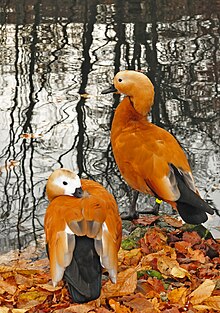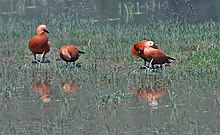Ruddy Shelduck
From Wikipedia, the free encyclopedia
| Ruddy Shelduck | |
|---|---|
 | |
| Pair | |
| Conservation status | |
| Scientific classification | |
| Kingdom: | Animalia |
| Phylum: | Chordata |
| Class: | Aves |
| Order: | Anseriformes |
| Family: | Anatidae |
| Genus: | Tadorna |
| Species: | T. ferruginea |
| Binomial name | |
| Tadorna ferruginea (Pallas, 1764) | |
| Synonyms | |
| Casarca ferruginea Anas ferruginea Casarca rutila | |
Contents[hide] |
[edit] Distribution
There are very small resident populations of this species in north west Africa and Ethiopia, but the main breeding area of this species is from south east Europe across central Asia to southeast China. These birds are mostly migratory, wintering in southern Asia.Although becoming quite rare in southeast Europe and southern Spain, the Ruddy Shelduck is still common across much of its Asian range. It may be this population which gives rise to vagrants as far west as Iceland, Great Britain and Ireland. However, since the European population is declining, it is likely that most occurrences in western Europe in recent decades are escapes or feral birds. Although this bird is observed in the wild from time to time in eastern North America, no evidence of a genuine vagrant has been found.
[edit] Descriptions
This is a bird of open country, and it will breed on cliffs,[1] in burrows, tree holes or crevices distant from water, laying 6-16 creamy-white eggs, incubated for 30 days. The Ruddy Shelduck is usually found in pairs or small groups and rarely forms large flocks. However, moulting and wintering gatherings on chosen lakes or slow rivers can be very large.The Ruddy Shelduck is a distinctive species, 58–70 cm long with a 110–135 cm wingspan. It has orange-brown body plumage and a paler head. The wings are white with black flight feathers. It swims well, and in flight looks heavy, more like a goose than a duck. The sexes of this striking species are similar, but the male has a black ring at the bottom of the neck in the breeding season summer, and the female often has a white face patch. The call is a loud wild honking.
The genus name Tadorna comes from Celtic roots and means "pied waterfowl", essentially the same as the English "shelduck".[2]
[edit] In culture
It is identified with the Akkadian "iṣṣūr ḫurri".[3] In Tibet and Mongolia, Ruddy Shelduck is considered sacred by the Buddhists. It is also a sacred animal in Slavic mythology.[citation needed][edit] In Indian culture
In Sanskrit, it is known as the chakravaka (चक्रवाक, IAST: cakravāka) or chakra (चक्र), and also as कामिन्, कोक, or द्वंद्वचर/द्वंद्वचारिन् ("living in couples").[4][5] In Indian literature, cakravāka birds are traditionally considered examples of conjugal love and fidelity.[6][7] When describing (human) married couples, poems often describe them as "attached to each other like cakravāka birds".[6] Cakravāka couples are believed to separate and mourn each night, and reunite during the day.[5][8] During the night the male and female bird call out to each other from opposite banks of the stream.[9] Thus they long for the sunrise, and the sun is considered a friend of the cakravāka birds (kokabandhu).[8][10]The bird is also known as an_r_il in Tamil and annal in Malayalam,[11] and as cengkerawak in Indonesian.[12]



No comments:
Post a Comment